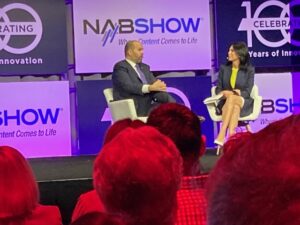
After more than 40 years of operation, DTVE is closing its doors and our website will no longer be updated daily. Thank you for all of your support.
NAB’s LeGeyt: broadcasters should focus on local to take on big tech
US broadcasters’ can continue to thrive in the age of streaming by doubling down on their strength in connecting with local audiences, according to Curtis LeGeyt, president and CEO, NAB.
Speaking at the opening session of the NAB Show main stage conference, LeGeyt hit on a perennial theme at the event – US broadcasters’ supposed unique connection to their local neighbourhoods. Broadcast’s competitive advantage “has always been, and continues to be, local”, said LeGeyt.
He said that, despite the rise of streaming, serving local communities was something “no one else is doing”.
LeGeyt, said that local broadcast can “bring together people of all sorts of different persuasions”. By local, he said the specifically meant “geographically local”.
LeGeyt, who was interviewed on stage by Univision’s Noticias 24 anchor Gabriela Teissier, said that broadcasters served Latino communities, who he said were “susceptible to disinformation” disseminated on social media, by providing “fact-based” news and information.
He said that maintaining support for local journalism was a key priority for NAB. “Regardless of partisanship, there is interest in ensuring that there is coverage of local news,” he said. He claimed that broadcasters were “the most trusted medium out there”, filling “an enormous void left by the newspaper industry”.
New rules
LeGeyt said the FCC had a major role to play to enable broadcasters to compete with tech “behemoths”. “Those rules of the road need to be modernised both locally and nationally,” he said.
Alluding to criticism of the FCC’s recent decision to refer the proposed merger of broadcast groups Standard General and Tegna to an administrative judge, LeGeyt said that there may be a need to update how such mergers are viewed in the light of competition with “unregulated” tech giants.
LeGeyt said the FCC also had a role to play in ensuring that ATSC 3.0/NextGen TV reached the parts of the country yet to be covered and access on a broader range of devices.
He said that there was a question over whether rules that had enabled broadcasters to “reinvest” money gained from carriage via cable now needed to be “extended to these OTT platforms” that consumers were turning to in place of cable.
In a wide-ranging interview, LeGeyt said that there was also a need to look at the impact of AI on the industry. He said that if AI developed the ability to scrape content including the work of broadcasters at a highly-granular level, there was a need to somehow ensure that broadcasters are compensated for the use of their intellectual property.
Innovation
LeGeyt said that innovations on display at the NAB Show would improve broadcasters’ ability to serve the local audiences. However, he said innovations such as ATSC 3.0 and automotive delivery were not enough to maintain that “community connection” in “five, 10, 20 years”.
LeGeyt said that NextGen TV was vital as an enabler of that local service. It would “enable us to take that local service…and improve the quality of what the viewer is getting via local over-the-air broadcast to compete with the best that is out there”, meaning that it will enable broadcasters to match the quality of streaming services.
He said “free local live” TV would “enable broadcasters to thrive”.
LeGeyt said that broadcasters were “in serious competition” for “space on the dashboard” in cars in competition with the likes of Apple and Spotify.
He said that local broadcast radio “is owned by more than a thousand different groups” in contrast to big audio streamers, meaning they have to collaborate to innovate.
“NAB has taken a real leadership role,” he said. “Once we are providing that live user experience we will thrive because we are the only [party] that is doing local,” he said.



